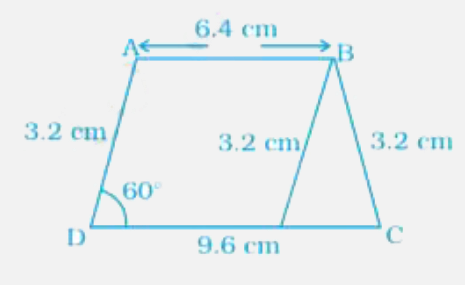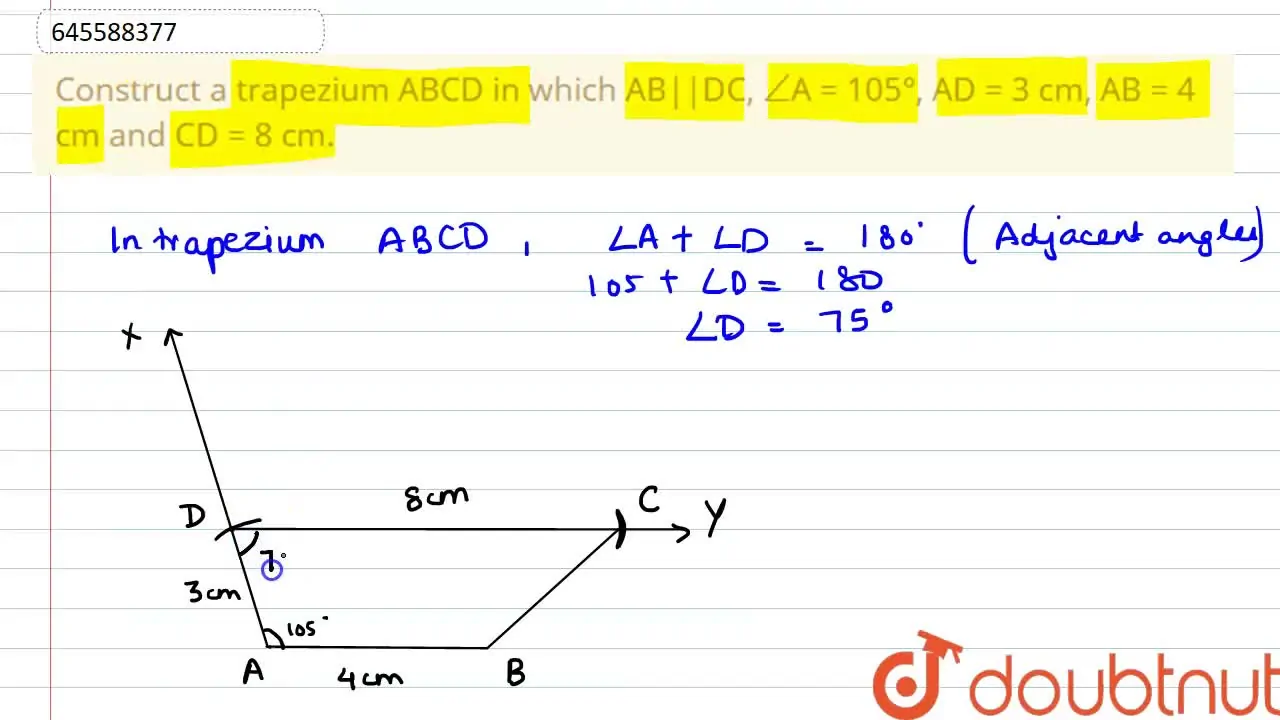Construct a trapezium ABCD in which AB||DC, ∠A = 105°, AD = 3 cm, AB = 4 cm and CD = 8 cm.
Step by step video & image solution for Construct a trapezium ABCD in which AB||DC, angleA = 105°, AD = 3 cm, AB = 4 cm and CD = 8 cm. by Maths experts to help you in doubts & scoring excellent marks in Class 8 exams.
Related Playlists
- BOOK - NCERT EXEMPLARCHAPTER - UNDERSTANDING QUADRILATERALS AND PRACTICAL GEOMETRYEXERCISE - APPLICATIONS, GAMES AND PUZZLES3videos
UNDERSTANDING QUADRILATERALS AND PRACTICAL GEOMETRY
- BOOK - NCERT EXEMPLARCHAPTER - UNDERSTANDING QUADRILATERALS AND PRACTICAL GEOMETRYEXERCISE - THINK AND DISCUSS2videos
UNDERSTANDING QUADRILATERALS AND PRACTICAL GEOMETRY
- BOOK - NCERT EXEMPLARCHAPTER - UNDERSTANDING QUADRILATERALS AND PRACTICAL GEOMETRYEXERCISE - THINK AND DISCUSS2videos
UNDERSTANDING QUADRILATERALS AND PRACTICAL GEOMETRY
- BOOK - NCERT EXEMPLARCHAPTER - SQUARE - SQUARE ROOT AND CUBE-CUBE ROOTEXERCISE - Exercise52videos
SQUARE - SQUARE ROOT AND CUBE-CUBE ROOT
- BOOK - NCERT EXEMPLARCHAPTER - VISUALISING SOLID SHAPES EXERCISE - EXERCISE91videos
VISUALISING SOLID SHAPES
Similar Questions
Construct a trapezium ABCD where AB||CD, AD = BC = 3.2cm, AB = 6.4 cm and CD = 9.6 cm. Measure ∠B and ∠A.

[Hint : Difference of two parallel sides gives an equilateral triangle.]View SolutionFind the area of a trapezium ABCD in which AB || DC, AB = 26cm, BC = 25cm, CD = 40cm and DA = 25cm.
View SolutionFind the area of a trapezium ABCD in which AB∣∣DC,AB=77cm,BC=25cm,
CD=60cmandDA=26cm.View SolutionConstruct a trapezium ABCD in which AB∣∣CD,AB=8.2cm,BC=3.4cm,CD=3.4cm and∠B=75∘.
View SolutionConstruct a trapezium ABCD in which AB=7cm, BC=4cm, CD=3.2cm, ∠B=75∘ and DC∣∣AB.
View SolutionABCD is a trapezium in which AB∣∣CD,AB=20cm,BC=10 cm, CD=10 cm and AD=10 cm . Find ∠ADC
View SolutionConstruct a quadrilateral ABCD in which AB = AD = 5cm, BC = CD = 7cm and BD = 6cm. What type of quadrilateral is this?
View SolutionABCD is a trapezium in which AB || DC, ABデ78 cm, CD = 52 cm. AD = 28 cm and BC =30cm . Find the area of the trapezium.
View SolutionConstruct a quadrilateral ABCD in which AB = 4.2 cm ∠A=80∘,BC=2.4cmCD=3.3cm,andAD=2.4cm
View SolutionConstruct a quadrilateral ABCD in which AB=4.2 cm, ∠A=80∘,BC=2.4cm,CD=3.3cm and AD=2.4cm.
View Solution


